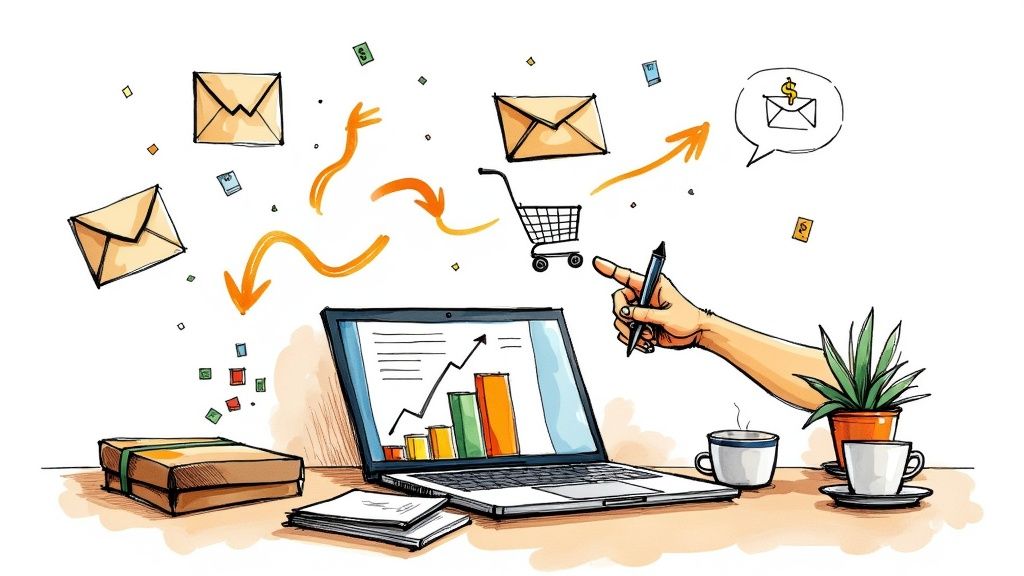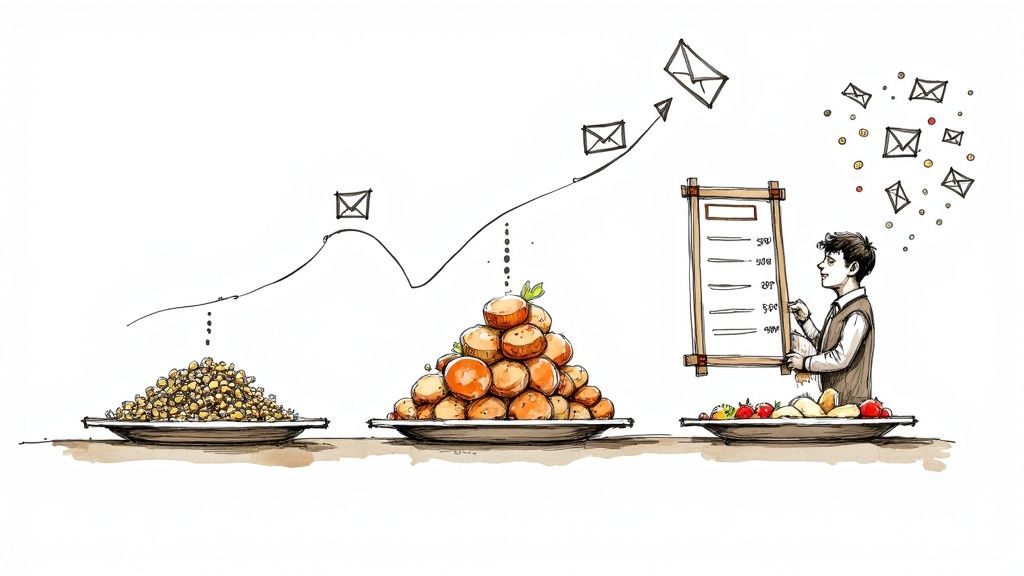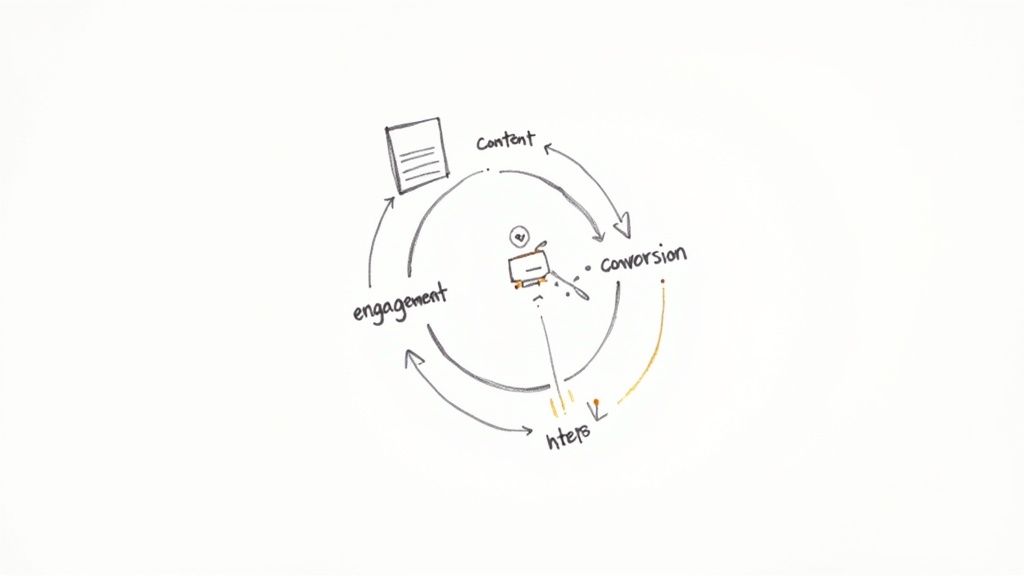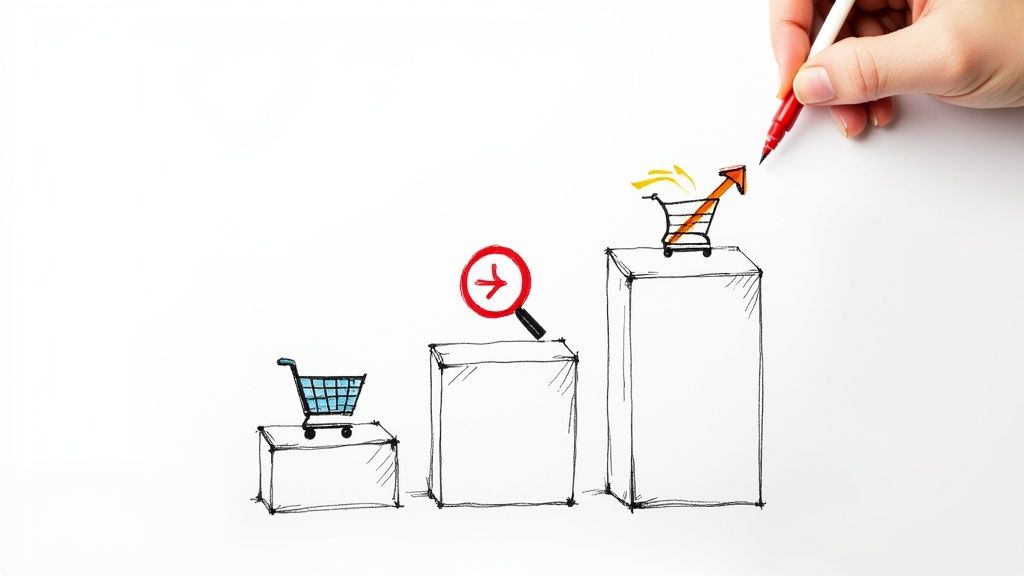10 Customer retention strategies ecommerce You Should Know

17 mins
6/14/2025
Joe Ervin
- customer
- guide
- tips
- strategies
- list
Getting Started
Acquiring new customers is expensive. Retaining existing ones is significantly more profitable. This curated list of ten proven customer retention strategies, specifically tailored for ecommerce businesses like yours, offers actionable insights to boost your bottom line. Whether you own a skincare brand, clothing line, or any other online store, these strategies are designed to turn one-time buyers into loyal advocates.
This listicle provides a comprehensive overview of customer retention strategies ecommerce, going beyond the basics to offer fresh perspectives and practical implementation details. You'll learn how to create personalized experiences that resonate, build a thriving community around your brand, and ultimately, increase customer lifetime value.
We'll explore proven tactics, including personalized email marketing, robust loyalty programs, and optimizing the post-purchase experience. We'll also dive into more advanced concepts like predictive analytics to prevent customer churn and omnichannel engagement for a seamless brand experience. Each strategy includes real-world examples and actionable advice you can implement immediately. Skip the generic advice; this list delivers concrete steps to bolster your customer retention strategies ecommerce and cultivate lasting relationships with your customers.
1. Personalized Email Marketing & Segmentation
Boost your customer retention rates with the power of personalized email marketing and segmentation. This strategy moves beyond generic email blasts and focuses on delivering highly targeted messages to specific customer segments. By leveraging data like purchase history, browsing behavior, and demographics, you can craft emails that resonate with individual customers, fostering stronger relationships and encouraging repeat purchases. This personalized approach makes customers feel valued and understood, increasing their likelihood of returning to your store.

Examples of Personalized Email Marketing in Action
- Amazon: Sends product recommendations based on past purchases and browsing activity.
- Spotify: Delivers personalized playlists and year-end summaries based on listening habits.
- Sephora: Offers beauty profile-based product suggestions and tutorials. These examples highlight how personalized emails enhance the customer experience and drive repeat business.
Actionable Tips for Implementing Personalized Email Marketing
- Start simple: Segment customers based on Recency, Frequency, and Monetary value (RFM).
- Leverage behavioral triggers: Send targeted emails for cart abandonment and browse abandonment.
- Progressive profiling: Gradually collect customer data to enrich your segments.
- Test and optimize: Experiment with send times and frequency for each segment.
- Incorporate social proof: Include user-generated content in your personalized emails.
- Maintain clean lists: Regularly clean your email list to ensure high deliverability rates.
When and Why to Use Personalized Email Marketing
Personalized email marketing is especially effective for ecommerce businesses with a growing customer base and sufficient data to create meaningful segments. This strategy helps nurture customer relationships, increase customer lifetime value, and drive sustainable growth. It shifts marketing from a one-size-fits-all approach to a targeted strategy focused on individual customer needs and preferences. By delivering the right message to the right customer at the right time, you cultivate loyalty and maximize your return on investment.
2. Loyalty Programs & Rewards Systems
Loyalty programs and rewards systems are structured programs designed to incentivize repeat purchases and ongoing engagement. They offer points, rewards, exclusive benefits, or tiered status to customers. These programs create a psychological connection between spending and rewards, encouraging customers to consolidate their purchases with one brand instead of shopping around. This, in turn, boosts customer retention rates and increases customer lifetime value for ecommerce businesses.

Examples of Successful Loyalty Programs
- Starbucks Rewards: Integrates a mobile app with personalized offers and gamified progress tracking.
- Amazon Prime: Offers a comprehensive ecosystem of benefits, including free shipping, streaming services, and exclusive deals.
- Sephora Beauty Insider: Provides tiered benefits, exclusive events, and personalized product recommendations.
Actionable Tips for Implementing Loyalty Programs
- Simple Structure: Design easy-to-understand earning and redemption structures.
- Varied Rewards: Offer both transactional (discounts) and experiential rewards (early access).
- Personalization: Use data analytics to tailor reward offerings to individual customer preferences.
- Surprise & Delight: Implement unexpected rewards for top-tier members.
- Clear Communication: Regularly communicate program value and member progress.
- Data Integration: Integrate loyalty data with other marketing channels for a holistic view of the customer.
When and Why to Use Loyalty Programs
Loyalty programs are particularly effective for ecommerce businesses looking to foster long-term customer relationships and drive repeat purchases. They create a sense of community and exclusivity, making customers feel valued and appreciated. Learn more about Loyalty Programs & Rewards Systems. This strategy is a proven method for increasing customer lifetime value and building a loyal customer base that contributes to sustainable business growth. By rewarding customer loyalty, you not only encourage repeat business but also gather valuable data that can inform future marketing efforts and enhance the overall customer experience.
3. Exceptional Customer Service & Support
Exceptional customer service and support goes beyond simply addressing issues. It's about creating positive, memorable experiences that foster loyalty and encourage repeat business. This involves providing multi-channel support, proactive problem-solving, and personalized assistance that exceeds customer expectations. Turning potential negative experiences into positive ones is key for customer retention strategies ecommerce.

Examples of Exceptional Customer Service in Action
- Zappos: Known for its legendary customer service culture and hassle-free returns.
- Nordstrom: Famous for its no-questions-asked return policy and personal shoppers.
- Chewy: Builds strong customer relationships with handwritten notes and pet loss sympathy flowers.
Actionable Tips for Implementing Exceptional Customer Service
- Empower representatives: Give them decision-making authority to resolve issues quickly.
- Comprehensive training: Focus on empathy, product knowledge, and problem-solving skills.
- Feedback loop: Use customer feedback to identify areas for improvement.
- Escalation procedures: Ensure quick resolution of complex issues.
- Invest in technology: Use tools that streamline support processes and personalize interactions.
When and Why to Use Exceptional Customer Service
Exceptional customer service is essential for all ecommerce businesses, especially those in competitive markets. It builds strong customer relationships, increases customer lifetime value, and drives positive word-of-mouth marketing. This approach differentiates your brand, builds trust, and transforms customers into loyal advocates. It's a crucial investment for sustainable growth and a key customer retention strategy for ecommerce.
4. Subscription & Membership Models
Subscription and membership models are powerful customer retention strategies for ecommerce businesses. These models foster ongoing relationships with customers through recurring payments in exchange for continuous value. This shifts the focus from one-time transactions to a predictable revenue stream, increasing customer lifetime value and reducing customer acquisition costs over time.

Examples of Subscription & Membership Models in Action
- Dollar Shave Club: Offers personalized razor blade delivery subscriptions.
- Netflix: Provides a content streaming subscription with personalized recommendations.
- Birchbox: Curates beauty sample subscriptions with options to purchase full-size products.
Actionable Tips for Implementing Subscription & Membership Models
- Compelling Onboarding: Demonstrate the subscription's value quickly.
- Flexible Options: Offer various subscription tiers to meet diverse needs.
- Data Analytics: Use data to predict and prevent customer churn.
- Win-Back Campaigns: Re-engage canceled subscribers with targeted offers.
- Continuous Value: Regularly add new features, products, or content.
- Easy Cancellation: Simplify the cancellation process but offer alternatives like pausing or downgrading.
When and Why to Use Subscription & Membership Models
Subscription and membership models are ideal for ecommerce businesses selling consumable products, curated experiences, or ongoing services. This strategy builds customer loyalty and provides a stable revenue base. By offering continuous value and personalized experiences, you encourage long-term customer engagement and maximize your profitability. This approach transforms your business from transactional to relational, fostering a community around your brand and products.
5. User-Generated Content & Community Building
User-generated content (UGC) and community building are powerful customer retention strategies for ecommerce. This approach transforms customers into brand advocates by encouraging them to share experiences and interact with your brand and each other. By creating a sense of belonging and leveraging social proof, UGC builds trust and fosters long-term loyalty. This organic engagement drives repeat purchases and strengthens your brand's online presence. Learn more about User-Generated Content & Community Building at Work With Trace.
Examples of UGC and Community Building in Action
- GoPro: Showcases customer adventure videos, transforming their brand into a platform for shared experiences.
- Starbucks: Encourages customer photos with the #RedCupContest, generating excitement and brand visibility.
- Airbnb: Leverages host and guest reviews to establish trust and transparency within their platform.
Actionable Tips for Implementing UGC and Community Building
- Create clear guidelines: Provide instructions on content formats and topics.
- Offer incentives: Reward content creation with discounts, features, or contests.
- Engage actively: Respond to comments and foster conversations.
- Feature customer content: Showcase UGC across your website and social media.
- Use branded hashtags: Organize and track user-generated content.
When and Why to Use UGC and Community Building
UGC and community building are particularly effective for ecommerce businesses selling experience-driven products or services. This strategy strengthens brand loyalty by fostering a sense of community and shared values. It is ideal for brands seeking authentic customer engagement and sustainable growth through word-of-mouth marketing. This approach shifts marketing from a monologue to a dialogue, building stronger customer relationships and driving customer retention strategies for ecommerce.
6. Retargeting & Remarketing Campaigns
Retargeting and remarketing campaigns are powerful digital advertising strategies specifically designed to re-engage customers who have previously interacted with your ecommerce brand but haven't completed a desired action, such as making a purchase. These campaigns leverage tracking pixels and cookies to follow customers across the web and social media platforms. This allows you to deliver personalized ads designed to bring them back to your store and complete their purchase or other conversion goals.
Examples of Retargeting and Remarketing in Action
- Amazon: Displays product recommendation ads on various websites based on previous browsing activity.
- Facebook: Uses dynamic product ads showcasing abandoned cart items to encourage customers to return and complete their purchase.
- Google Shopping: Implements retargeting ads for previous website visitors, highlighting products they viewed.
Actionable Tips for Implementing Retargeting and Remarketing
- Segment your audience: Group customers based on specific actions (e.g., product page views, add to cart) and engagement levels.
- Sequential messaging: Craft a story across multiple touchpoints with different ad creatives.
- A/B testing: Experiment with various ad formats, creatives, and calls-to-action to optimize performance.
- Frequency capping: Set limits to avoid overwhelming customers with too many ads.
- Exclusion lists: Exclude recent purchasers to prevent wasted ad spend and improve the customer experience.
- Omnichannel approach: Integrate retargeting with email marketing for a cohesive and consistent brand experience.
When and Why to Use Retargeting and Remarketing
Retargeting and remarketing are essential customer retention strategies for ecommerce businesses looking to recapture lost sales and improve conversion rates. These strategies are particularly effective for reaching customers who have demonstrated interest in your products or brand but haven't yet converted. By strategically reminding them of your offerings and providing personalized incentives, you can effectively bring them back into the sales funnel and increase customer lifetime value. Retargeting maximizes your return on ad spend by focusing on customers already familiar with your brand.
7. Post-Purchase Experience Optimization
Boost customer retention by optimizing the post-purchase experience. This strategy transforms the often-overlooked period after a purchase into a prime opportunity for building loyalty and encouraging repeat business. It encompasses everything from order confirmation and shipping updates to product onboarding, support, and returns, ensuring a seamless and positive experience that keeps customers coming back. A positive post-purchase experience fosters trust and strengthens the customer relationship.
Examples of Post-Purchase Experience Optimization in Action
- Apple: Creates a premium unboxing experience with sleek packaging.
- Warby Parker: Offers a try-at-home program with hassle-free returns.
- Chewy: Sends personalized pet portraits and handwritten notes. These examples demonstrate how thoughtful post-purchase interactions can create a lasting impression.
Actionable Tips for Implementing Post-Purchase Experience Optimization
- Map the customer journey: Understand every touchpoint from purchase to product mastery.
- Proactive updates: Keep customers informed about order status and shipping.
- Helpful resources: Provide tutorials or guides for using the product effectively.
- Solicit feedback: Ask for reviews and suggestions for improvement.
- Surprise and delight: Offer unexpected upgrades or small gifts.
- Easy returns: Simplify the return process for a seamless customer experience.
When and Why to Use Post-Purchase Experience Optimization
Post-purchase experience optimization is crucial for any ecommerce business aiming to build long-term customer relationships and drive repeat purchases. This strategy is particularly effective for businesses with subscription models or products that require ongoing engagement. It demonstrates that you value your customers beyond the initial transaction, fostering loyalty and advocacy. By exceeding customer expectations after the sale, you create a positive feedback loop that leads to sustainable growth and increased customer lifetime value. This approach transforms a transactional interaction into a relationship-building opportunity, turning one-time buyers into loyal brand advocates. It's a key component of a comprehensive customer retention strategy for ecommerce success.
8. Dynamic Pricing & Personalized Offers
Boost customer retention with dynamic pricing and personalized offers. This advanced strategy uses data analytics and customer insights to tailor pricing and promotions to individual customers or segments. By presenting the right offer at the right time, you optimize both revenue and customer satisfaction. This approach acknowledges that different customers have varying price sensitivities and preferences, leading to a more personalized and effective retention strategy.
Examples of Dynamic Pricing & Personalized Offers in Action
- Amazon: Adjusts prices in real-time based on competition and demand.
- Uber: Implements surge pricing during periods of high demand.
- Airlines: Utilize dynamic pricing based on booking patterns and seasonality.
- Netflix: Offers personalized content recommendations, impacting perceived value and justifying subscription costs.
Actionable Tips for Implementing Dynamic Pricing & Personalized Offers
- Start simple: Segment customers based on purchase history and behavior before using complex algorithms.
- Transparency: Be upfront about your pricing policies to build and maintain customer trust.
- Test and learn: Experiment with pricing strategies on small customer segments before full-scale implementation.
- Market awareness: Monitor competitor pricing and overall market conditions regularly.
- Value perception: Use price anchoring and bundling to enhance the perceived value of your offers.
- Legal compliance: Ensure adherence to local pricing and anti-discrimination laws.
When and Why to Use Dynamic Pricing & Personalized Offers
Dynamic pricing and personalized offers are particularly effective for ecommerce businesses with a substantial customer base and access to detailed data. This customer retention strategy increases customer lifetime value by catering to individual needs and preferences. It moves beyond static pricing models and embraces a flexible approach that maximizes revenue while fostering customer loyalty. By aligning pricing with individual customer value, you encourage repeat purchases and build stronger customer relationships.
9. Omnichannel Customer Experience
Enhance customer retention strategies for ecommerce by providing a unified omnichannel customer experience. This approach creates seamless and consistent interactions across all touchpoints, including online, mobile, social media, phone, and physical stores. Customers can effortlessly transition between channels, fostering a cohesive brand experience that builds loyalty and minimizes churn. This strategy recognizes that customers interact with brands in various ways and prioritizes a consistent experience regardless of the channel.
Examples of Omnichannel Customer Experience in Action
- Disney: The MagicBand system seamlessly integrates park, hotel, and app experiences.
- Starbucks: The mobile app integrates with the in-store experience for ordering and rewards.
- Sephora: The Beauty Insider program connects online, mobile, and retail store interactions.
- Target: Offers convenient buy online, pick up in store (BOPIS) and same-day delivery.
Actionable Tips for Implementing Omnichannel Customer Experience
- Map customer touchpoints: Identify all interaction points and potential friction areas.
- Unify customer data: Invest in a robust customer data platform for a holistic view.
- Train your staff: Ensure consistent brand standards and customer service across all channels.
- Gradual integration: Implement changes step-by-step rather than all at once.
- Prioritize with feedback: Use customer feedback to identify key integration opportunities.
- Consistent information: Maintain uniform inventory and pricing across all channels.
When and Why to Use Omnichannel Customer Experience
Omnichannel strategies are essential for ecommerce businesses aiming to cultivate long-term customer relationships. This approach is particularly valuable for brands with diverse touchpoints, seeking to create a cohesive brand experience. It strengthens customer loyalty by offering convenient, personalized interactions, regardless of how customers choose to engage. Learn more about Omnichannel Customer Experience. By removing friction and providing a consistent experience, you can significantly boost customer retention rates and drive sustainable growth within the competitive ecommerce landscape.
10. Predictive Analytics & Churn Prevention
Boost customer retention with predictive analytics. This data-driven strategy uses algorithms and statistical models to identify at-risk customers before they churn. By analyzing behavior patterns, engagement metrics, and historical data, you can predict future actions and intervene proactively. Targeted retention campaigns and personalized offers can prevent customer loss and boost loyalty.
Examples of Predictive Analytics in Action
- Netflix: Predicts viewing preferences and churn risk to personalize recommendations and offers.
- Spotify: Analyzes listening patterns to prevent subscription cancellations with tailored promotions.
- Ecommerce Retailers: Monitor purchase history and browsing behavior to identify customers likely to make repeat purchases, then target them with exclusive deals.
Actionable Tips for Implementing Predictive Analytics
- Start simple: Begin with basic behavioral indicators like purchase frequency and website activity.
- Focus on action: Prioritize actionable predictions over perfect accuracy. Even simple models can provide valuable insights.
- Combine data: Integrate multiple data sources for a more comprehensive understanding of customer behavior.
- Vary interventions: Create different retention strategies based on predicted risk levels. High-risk customers may need more personalized attention.
- Regular updates: Validate and update your predictive models regularly to maintain accuracy. Customer behavior changes over time.
- Train your team: Equip customer service teams to handle at-risk customer interactions effectively.
When and Why to Use Predictive Analytics
Predictive analytics is especially valuable for ecommerce businesses with substantial customer data. It allows for proactive intervention, preventing churn before it occurs. This strategy shifts from reactive customer retention to a proactive approach, maximizing customer lifetime value and driving sustainable growth. By anticipating customer needs and addressing potential issues early on, you can cultivate stronger relationships and improve retention rates. This targeted approach allows for efficient allocation of resources, focusing retention efforts where they are most needed.
Customer Retention Strategies Comparison
| Strategy | Implementation Complexity 🔄 | Resource Requirements ⚡ | Expected Outcomes 📊 | Ideal Use Cases 💡 | Key Advantages ⭐ |
|---|---|---|---|---|---|
| Personalized Email Marketing & Segmentation | High - requires data management, automation setup | Moderate - CRM systems, data integration tools | Higher open & conversion rates, strong customer relationships | E-commerce, customer retention, targeted promotions | Cost-effective with high ROI, scalable automation |
| Loyalty Programs & Rewards Systems | High - complex management and maintenance | High - platform development, customer service | Increased lifetime value & engagement, word-of-mouth growth | Retail, subscription businesses, brand loyalty | Emotional brand connection, higher order frequency |
| Exceptional Customer Service & Support | High - multi-channel support, staff training | High - skilled teams, ongoing training costs | Increased retention, positive reviews, competitive differentiation | Service-heavy industries, high-touch customer segments | Builds trust, reduces churn, enables upselling |
| Subscription & Membership Models | Medium to High - billing systems, content delivery | Moderate to High - platform management, content | Predictable revenue, higher lifetime value | Recurring services, digital products, consumables | Recurring revenue, lower acquisition costs over time |
| User-Generated Content & Community Building | Medium - community management, content moderation | Moderate - platform tools, moderation resources | Increased engagement, authentic content, improved SEO | Brands focusing on social proof, lifestyle, and advocacy | Cost-effective marketing, strong emotional connections |
| Retargeting & Remarketing Campaigns | Medium to High - technical setup, ongoing optimization | Moderate - ad spend, analytics tools | Higher conversion rates, brand recall, measurable ROI | E-commerce, high-traffic websites, abandoned carts | Cost-effective re-engagement, targeted ads |
| Post-Purchase Experience Optimization | Medium to High - logistics coordination | High - operations, customer service, packaging | Increased satisfaction, reduced buyer's remorse, loyalty | E-commerce, subscription products, premium brands | Differentiates brand, encourages repeat purchases |
| Dynamic Pricing & Personalized Offers | High - requires advanced analytics and ML | High - data science, pricing engines | Optimized revenue, improved conversion rates | Retail, travel, services with variable demand | Revenue maximization, competitive advantage |
| Omnichannel Customer Experience | Very High - complex integration across channels | Very High - technology infrastructure, training | Increased satisfaction, loyalty, higher lifetime value | Retail, hospitality, brands with multiple touchpoints | Seamless experience, operational efficiency |
| Predictive Analytics & Churn Prevention | High - data science expertise, model maintenance | High - data collection, analytics platforms | Reduced churn, higher ROI from retention efforts | Subscription services, SaaS, telecom | Proactive retention, personalized interventions |
Final Thoughts
Building a thriving ecommerce business requires more than just attracting new customers; it demands a robust customer retention strategy. In this guide, we've explored ten proven ecommerce customer retention strategies that can significantly impact your bottom line. From personalized email flows to predictive analytics, each tactic offers a unique approach to cultivating customer loyalty and driving repeat purchases. Remember, acquiring a new customer is far more expensive than retaining an existing one.
The Value of Retention
Effective customer retention strategies ecommerce are essential for sustainable growth. By focusing on building relationships with your existing customers, you create a loyal base that's more likely to not only return for repeat purchases but also become brand advocates. This organic growth translates into increased revenue and stronger brand recognition within your niche. Whether you're a skincare brand, a clothing brand, or any other ecommerce business, a solid retention strategy is crucial.
Key Takeaways for Ecommerce Success
Let’s recap some of the most important takeaways for maximizing customer lifetime value:
- Personalization is Paramount: Tailoring your messaging and offers based on individual customer data is key for effective email marketing, dynamic pricing, and building a truly engaging omnichannel experience.
- Community Builds Loyalty: Foster a sense of belonging by encouraging user-generated content and building an active online community. This strengthens customer connections and promotes brand advocacy.
- Data-Driven Decisions: Leverage predictive analytics to identify potential churn risks and proactively address customer issues before they escalate. This proactive approach is vital for long-term retention.
- Optimize the Entire Customer Journey: From the initial purchase to post-sale support, every touchpoint contributes to the overall customer experience. Focus on streamlining processes and exceeding expectations at each stage.
Taking the Next Steps
Now that you have a better understanding of these customer retention strategies ecommerce, it's time to put them into action. Start by identifying the areas where your business can benefit the most. Perhaps your email marketing needs a personalization overhaul, or maybe your customer support could use a boost.
- Prioritize one or two strategies: Don't try to implement everything at once. Focus on a couple of key areas and build from there.
- Test and iterate: Continuously monitor the effectiveness of your chosen strategies and make adjustments as needed. What works for one brand might not work for another, so experimentation is key.
- Invest in the right tools: There are numerous tools available to help automate and streamline your retention efforts, from email marketing platforms to customer relationship management (CRM) systems.
By consistently implementing and refining these customer retention strategies ecommerce, you can build a loyal customer base, drive repeat purchases, and ultimately achieve sustainable growth for your business. Remember, retaining customers isn't just about transactions; it's about building relationships. Investing in these relationships will pay off in the long run, fostering a community of brand advocates who contribute to your ongoing success.





